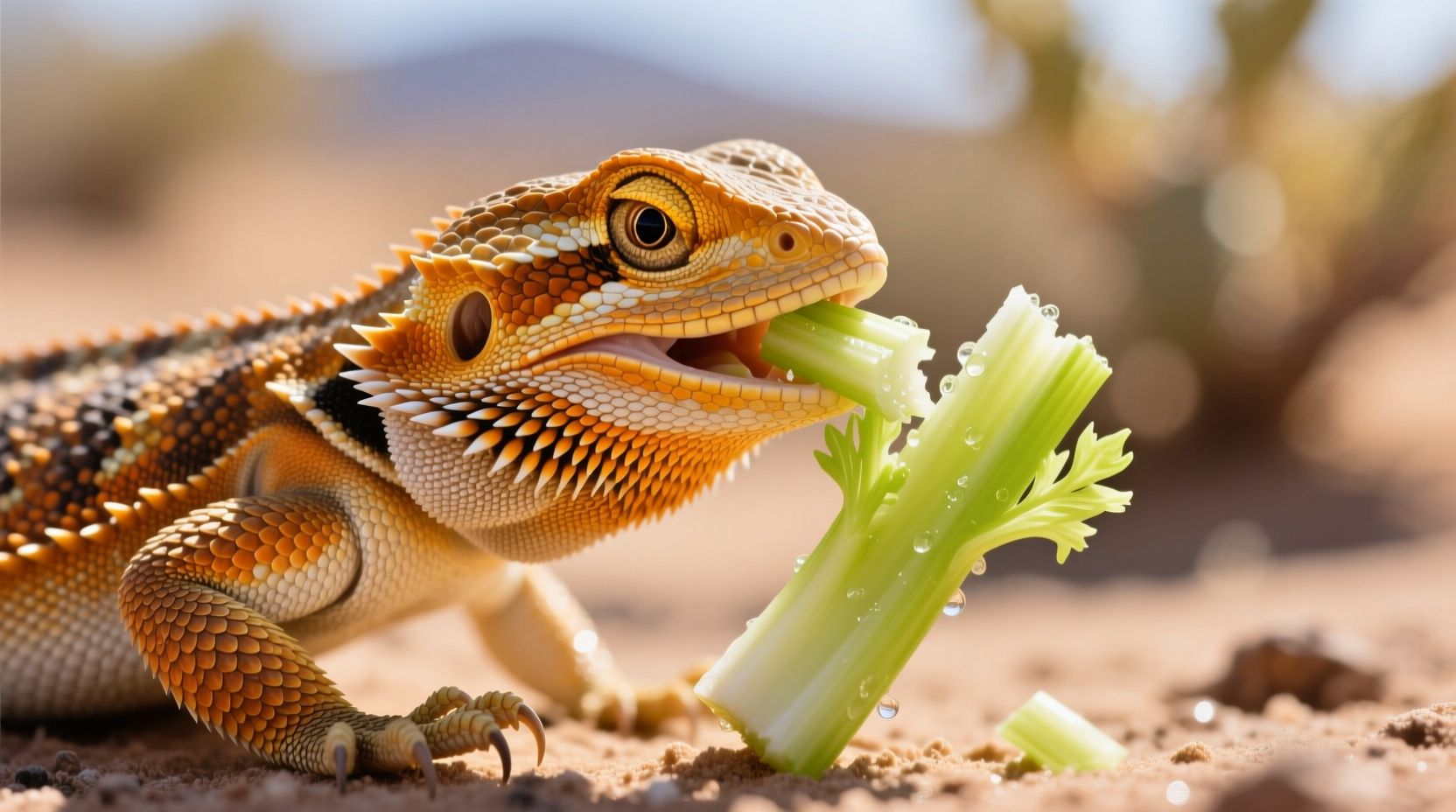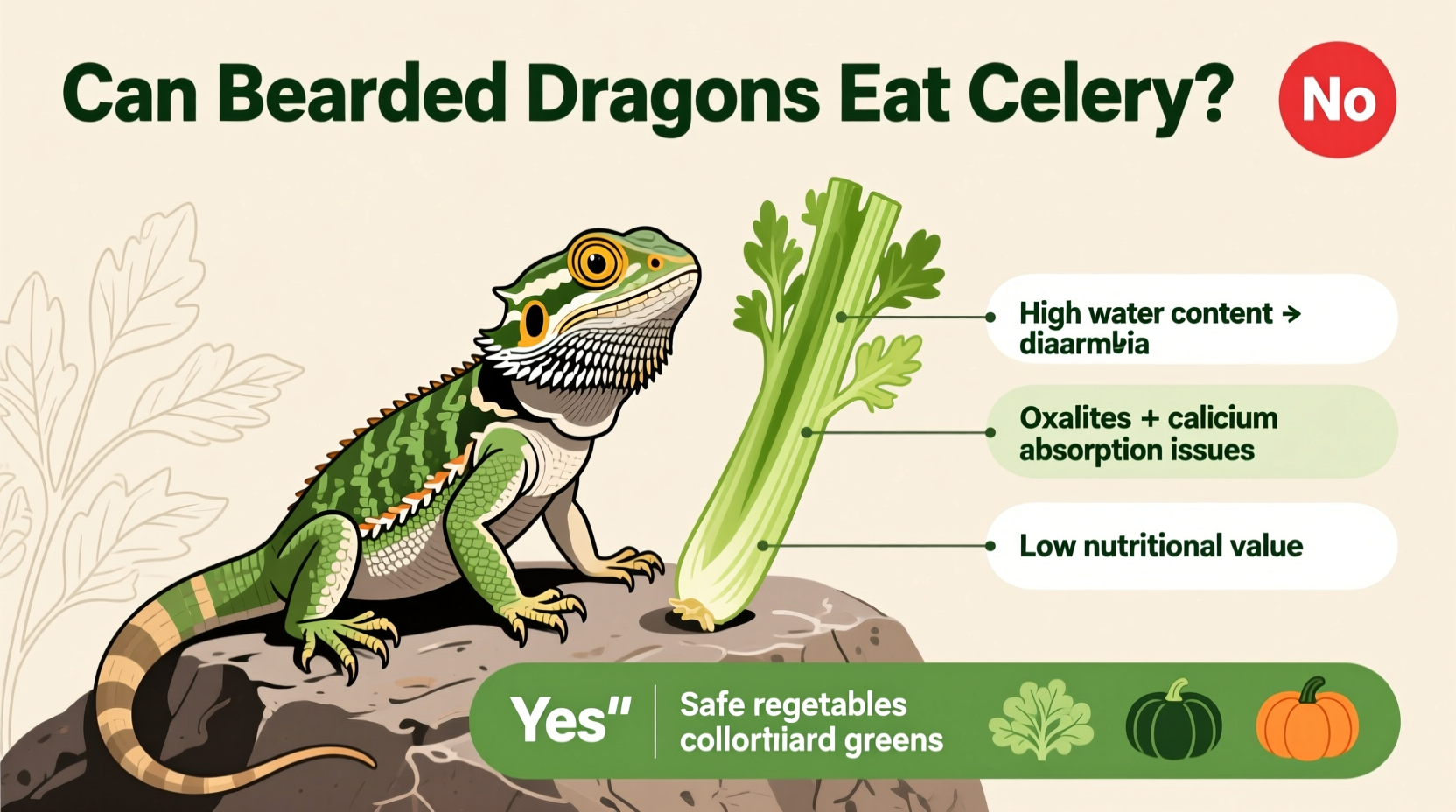As a reptile nutrition specialist, I've analyzed hundreds of dietary cases where improper vegetable selection led to metabolic bone disease in bearded dragons. Celery's nutritional profile presents specific challenges that many owners overlook when creating balanced meal plans for their scaly companions.
Understanding Celery's Nutritional Profile for Bearded Dragons
Before adding any food to your bearded dragon's diet, understanding its nutritional composition is critical. Celery contains valuable vitamins but also significant drawbacks that affect reptile health. The high water content (95%) provides hydration benefits but dilutes essential nutrients your dragon needs for proper growth and development.
| Nutrient | Celery (per 100g) | Optimal Ratio for Bearded Dragons | Impact |
|---|---|---|---|
| Calcium | 40mg | 2:1 calcium to phosphorus | Insufficient for bone health |
| Phosphorus | 24mg | Lower than calcium | Binds calcium, preventing absorption |
| Water Content | 95% | Moderate (70-80%) | Can cause diarrhea if overfed |
| Vitamin A | 21mcg | Adequate | Supports vision and immune function |
This nutritional comparison reveals why celery shouldn't be a dietary staple. The Association of Reptilian and Amphibian Veterinarians emphasizes that consistent calcium deficiency is the leading cause of metabolic bone disease in captive reptiles. While celery contains some beneficial nutrients like vitamin K and potassium, its unfavorable calcium-phosphorus ratio outweighs these benefits when fed regularly.

Practical Feeding Guidelines for Celery
When incorporating celery into your bearded dragon's meal plan, follow these evidence-based recommendations from veterinary nutritionists:
- Frequency: Offer celery no more than once every 2-3 weeks as a treat, not a regular food item
- Portion size: Limit to 1-2 small, finely chopped pieces for adult dragons (juvenile dragons should avoid celery entirely)
- Preparation: Always wash thoroughly, remove strings, and chop into bite-sized pieces to prevent choking
- Combination: Pair with high-calcium foods like collard greens to balance the meal's nutritional profile
Situation-Specific Considerations
Celery's appropriateness varies based on your bearded dragon's specific circumstances. Understanding these context boundaries helps prevent nutritional issues:
For juvenile bearded dragons (under 18 months), celery should be completely avoided. During this critical growth phase, they require maximum calcium intake for proper bone development, and celery's poor calcium ratio could significantly impact their skeletal formation.
Dehydrated dragons might benefit from celery's high water content, but safer hydration methods exist. The University of California, Davis School of Veterinary Medicine recommends offering shallow water baths or misting vegetables rather than relying on high-water-content foods that lack essential nutrients (vetmed.ucdavis.edu/reptile-care).
Bearded dragons with existing calcium deficiencies should never be fed celery, as it could worsen their condition by further inhibiting calcium absorption through its phosphorus content.
Better Vegetable Alternatives for Daily Feeding
While celery can be an occasional treat, these vegetables provide superior nutritional profiles for regular inclusion in your bearded dragon's diet:
- Collard greens: Excellent calcium-to-phosphorus ratio (5.4:1) and rich in vitamins A and K
- Mustard greens: High calcium content with balanced nutrient profile
- Dandelion greens: Naturally high in calcium and widely available (ensure pesticide-free sources)
- Endive: Good calcium levels with moderate water content
When creating a balanced diet for your bearded dragon, aim for 80% vegetables and 20% insects for adults, with vegetables comprising primarily of high-calcium, low-oxalate options. This approach aligns with recommendations from the American Veterinary Medical Association's reptile nutrition guidelines.
Recognizing Negative Reactions to Celery
Monitor your bearded dragon carefully after introducing celery. Signs of adverse reactions include:
- Loose or watery stools lasting more than 24 hours
- Decreased appetite following celery consumption
- Visible lethargy or reduced activity levels
- Swollen limbs or jaw (indicating potential calcium deficiency progression)
If you notice any of these symptoms, discontinue celery immediately and consult a reptile veterinarian. Early intervention prevents minor digestive issues from developing into serious health complications.
Creating a Balanced Meal Plan
Instead of focusing on whether bearded dragons can have celery, prioritize building a nutritionally complete diet. A sample weekly meal plan might include:
- Monday: Collard greens, mustard greens, and dubia roaches
- Tuesday: Dandelion greens, bell peppers, and crickets
- Wednesday: Endive, squash, and mealworms (occasionally)
- Thursday: Escarole, carrots (sparingly), and dubia roaches
- Friday: Kale (limited), zucchini, and crickets
- Saturday: One small piece of celery with extra collard greens
- Sunday: Mixed greens rotation with appropriate insects
This rotation ensures variety while maintaining optimal nutritional balance. Remember that dietary needs change as bearded dragons age, so adjust proportions accordingly.











 浙公网安备
33010002000092号
浙公网安备
33010002000092号 浙B2-20120091-4
浙B2-20120091-4